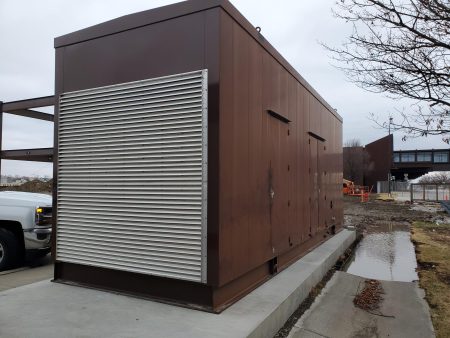When it comes to securing a reliable power source during power outages or in remote areas, the decision between stationary and standby generators becomes important. Stationary generators have impressive power limits and integrate into existing electrical systems. Standby generators offer flexibility and versatility, taking care of temporary power needs.
This article investigates the elements of each type, directing users towards informed decisions according to their particular requirements and concerns.
Stationary Generators

Stationary generators, also called backup generators, stand as powerful safeguards against power interruptions. Designed for significant power capacities, the generators range from 500 kW to 3000 kW, showing their ability to satisfy the needs of basic systems.
One of the primary features of stationary generators is their fixed installation. Generators like the 1993 CAT 3516 1750kW Diesel Generator Set consistently integrate into a building’s structural, and electrical framework, ensuring an automated power supply when the primary power grid fails. This automatic activation, facilitated by exchange switches, recognizes stationary generators as dependable solutions for organizations, hospitals, data centers, and different applications where continuous power is very important.
The reliability of stationary generators depends on their reliance on a constant fuel source. 2018 CAT C18 500kw Diesel Generator Set (EPA Tier 4 Final), managed by diesel, is appropriate for prolonged use without the requirement for frequent refueling. This feature makes them a trustworthy solution for associations requiring sustained power support.
Stationary generators address a commitment to continuous power, offering an automatic change during power outages and being a backbone of continuous operations.
Portable Generators

In the world of power generation, portable generators arise as flexible champions of versatility and flexibility. Unlike Stationary generators, these generators from Midwest Generators aim to transverse different locations, giving power where it’s required most.
The power limits of portable generators have a different reach, taking care of the needs of external events, construction sites, or any situation demanding a temporary power source. Models like the 2000 CAT XQ225 225kW Portable Diesel Generator Set’s adaptability reflects its capacity to move from one area to the other.
Portability is a characterizing component of these generators. Rather than a permanent installation, they offer a plug-and-play solution, requiring manual connection with machines or hardware through extension cords. This feature makes them ideal for situations where temporary power is important, allowing clients to adjust to changing needs without a proper system.
With extraordinary portability comes manual obligation. Unlike the automatic activation of fixed generators, portable units typically require manual startup. Clients take responsibility for starting and checking power distribution, offering a methodology that might suit situations where quick, on-the-spot decisions are fundamental.
Portable generators provide a unique way to deal with power provision. Their portability and versatility make them essential for different settings, whether it’s an outdoor event, a site, or any area needing a temporary power supply. For portable generators, the decision depends on the particular demands and requirements of the customer, with every generator type offering its own set of benefits.
Related product: 1996 Cat 3412 600kw Diesel Generator Set
Stationary vs Portable Generators: The Difference
| Criteria | Stationary Generators | Portable Generators |
| Power Capacity | Higher power capacities (e.g., Midwest Generators range from 500 kW to 3000 kW) | Varied power capacities, typically suited for smaller demands |
| Installation | Permanent installation hardwired into the electrical system | Temporary and mobile, no permanent installation required |
| Activation | Automatic activation with built-in transfer switches | Manual activation, requires user intervention to start |
| Fuel Source | Continuous fuel source (natural gas, propane) for prolonged use | Manual refueling, often relies on gasoline or diesel |
| Mobility | Fixed location, not designed for mobility | Portable, designed for easy transportation between locations |
| Flexibility | Suited for applications requiring constant, high-capacity power | Ideal for temporary needs, outdoor events, or construction sites |
| Use Cases | Critical infrastructure, businesses, hospitals, data centers | Outdoor events, construction sites, emergency power. |
| Cost | Higher upfront cost due to greater capacity and installation | Generally lower upfront cost, suitable for temporary needs |
| Ease of Use | Automated processes for seamless power transfer | Manual setup and connection to appliances or equipment |
| Start-Up Time | Immediate start during power outages | Requires user intervention, may have a startup time |
| Long-Term Reliability | Robust and reliable for prolonged, continuous operation | Suitable for intermittent and temporary power requirements |
Upgrade your Power Essentials with MidWest
Midwest Engines and Generators offers a favorable decision between stationary and portable generators depending upon the requirements of the situation. Stationary generators offer high capacity and continuous power, while portable generators offer adaptability and versatility for temporary requirements. Factors like power demands, mobility, and budget considerations play an important role in selecting the most suitable option.
Whether looking for the reliability of a stationary generator or the adaptability of a portable unit, a thoughtful choice ensures a dependable power supply customized to the specific demands of any situation. So, if you’re looking to buy or sell your next generator or are researching for your next generator, our knowledgeable team at MEG is here to assist!
See related: Top 6 500KW diesel generators for sale
Common Questions about Stationary and Portable Power Generators
Q1. What is the Primary Purpose of Stationary Generators?
Stationary generators are intended for heavy foundations, giving high-capacity power during outages.
Q2. How do Portable Generators Differ from Stationary Ones?
Portable generators are compact, temporary solutions appropriate for occasions, construction sites, or situations with differing power needs.
Q3. Do Stationary Generators Require Manual Activation During Power Outages?
No, stationary generators have manual activation with built-in transfer switches for consistent power.
Q4. What Fuels Stationary Generators?
Stationary generators frequently depend on fuel sources like natural gas or propane, ensuring prolonged use without regular refueling.
Q5. Are Portable Generators Suitable for Long-Term Use?
Portable generators are more suitable for temporary power needs, and they might require manual refueling.
Q6. Can Portable Generators be Permanently Installed?
No, portable generators are made for temporary use and are not permanently installed.
Q7. Which Generator Type is More Cost-Effective?
Portable generators have a lower cost, making them a cost-effective decision for temporary power requirements, while stationary generators might require a higher installation cost.
Q8. Are Portable Generators Automated During Power Outages?
No, portable generators usually require manual activation by the user, offering a hands-on approach to power management.
Q9. Can Stationary Generators be Moved to Different Locations Easily?
No, stationary generators are designed for fixed installations and are not easily moved, making them less suitable for changing operational locations.
Q10. How Do I Know Which Generator is Best for My Needs?
To choose between stationary and portable generators, consider factors like power requirements and budget requirements. Check the particular requirement, whether it’s continuous power for basic systems or temporary power for occasions or construction sites.


